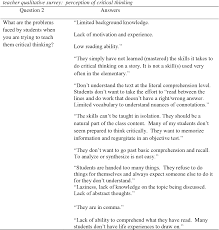Why do students find it so difficult to think critically? One reason may be that they don’t have the cognitive ability to grasp the complex rules and processes involved in critical thinking. Another possible reason is that education puts a heavy burden on the educator to develop critical thinking skills. Students should learn critical thinking skills, as well as collaborate with one another. Ideally, teachers will make this process as easy as possible. In the meantime, students should practice critical thinking every day and be encouraged to engage in such activities.
Cognitive impairment prevents people from grasping the complex rules and processes of critical thinking
In some cases, a condition causing cognitive impairment may be the result of another condition. This can include memory loss, learning disabilities, concentration problems, decreased intelligence, or other symptoms of diminished mental function. Some conditions can cause cognitive impairment at any time in a person’s life, from birth through old age. In very young children or newborns, the cause is often not known, but it may be the result of some other illness or injury, or a medication.
Some forms of cognitive impairment may cause a person to be unable to understand abstract thinking. Traumatic experiences or organic brain damage can negatively impact areas of the brain that enable critical thinking. Mental illness can also affect this cognitive ability, as can a child’s environment or a caregiver’s actions. In such cases, parents, teachers, or caregivers can help their children develop these skills by encouraging them to ask questions and think. This will help children develop their ability to think, reflect, and engage in critical thinking.
Education places the onus on the educator to teach critical thinking
The notion of teaching critical thinking is a high-level goal of educators. Many “teacher moves” are aimed at developing this skill. One of the best examples is repeatedly asking higher-order thinking questions. However, this technique alone is not sufficient to foster this skill. Educators must develop more effective techniques to encourage critical thinking among students. Here are a few ideas to consider. These ideas may help you develop critical thinking skills in your students.
Teachers are often not used to teaching critical thinking because the emphasis is on rote memorization and fact-based teaching. This focus often leaves fewer opportunities for students to ask open-ended questions and develop their critical thinking skills. The onus on educators to develop critical thinking skills is not a one-time task, however. All teachers have different backgrounds and expertise in teaching critical thinking, and they should be aware of the challenges and the rewards of incorporating these strategies into their classrooms.
Collaboration is an essential part of problem solving
There are many ways for students to collaborate and learn. It is important for them to be involved in the class discussions. But for students who are shy or uncomfortable speaking up in front of their peers, collaboration can be challenging. Digital tools, such as Padlet, can help students share ideas, post photos, videos, web links, and audio. Students can also share what they’ve learned with the rest of the group.
Collaborative discussion requires peer interaction, communication, and sharing, and expert guidance. Students should be responsible for driving the conversations; they will refine their understanding, think critically, and synthesize information in the process. They may not have the time to think critically and collaborate in small groups, but they will learn from the process. Collaboration helps students to overcome obstacles in their learning. It is also an essential part of problem solving for students who can’t think critically.

